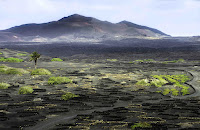 |
| Courtesy of vineyards.com |
The Canary Islands archipelago is an interesting region for growing grapes as it is the most tropical of Europe's wine regions. Lying off the west coast of Morocco, the tropical climate is generally hot and humid but there are numerous micro-climates and topographical features that make wine production possible. The altitude of the stone-terrace vineyards is vital and for the majority, it ranges from 1,600-3,300 feet above sea level, providing a string diurnal temperature change. This ensures that freshness and acidity are maintained in the grapes.
 |
| Courtesy of La Geria Winery |
Wine is made on seven of the eight main islands, encompassing 11 Denominaciones de Origen Protegida (DOPs), the overall Islas Canarias DOP, five individual islands, and five located on the largest island - Tenerife. Today's focus is on the easternmost island - Lanzarote - known for the uniqueness of its volcanic (lunar) landscape. In general, the island has a temperate climate as a result of its proximity to Africa coupled with cooling breezes from the Atlantic Ocean. Plus there is an abnormally large drop in nighttime temperatures enhancing acidity and lengthening the growing season.
According to wine-searcher.com, "Lanzarote's landscape was transformed from 1730 to 1736 by a series of volcanic eruptions. It covered around a third of the land in thick black lava and ash and destroyed the island's traditional agricultural crops, such as wheat. However, it created the conditions for the island to start its wine production." Forced to innovate, the vines are planted in cones formed in the lapilli, locally called picón, and additionally protected by small dry stone walls. This type of planting allows the plants to root more easily in the fertile soil, while the upper layer of lapilli reduces evaporation. In addition, the shape of the holes and the additional wall protect the crops from the wind. |
| Courtesy of La Geria Winery |
Listán Negro is the most most cultivated red wine grape planted in the Canary Islands - and is most dominant in the Tacoronte-Acentejo DOP that covers the island of Tenerife. It is a black-skinned grape formed into funnel shaped and compact clusters The berry, itself, is medium-sized, spherical, and blue-black. It adapts very well to northern slopes, medium altitude and more evolved soils with a higher level of clay, where it maintains acidity, achieves good alcohol content and good phenolic ripening. Most interesting is that DNA studies have shown that this grape variety is not a mutation of Palomino Fino (Listan Blanco in the Canary Islands). It is autochthonous to the archipelago. Wines made from Listán Negro vary considerably in style, from rosé wines to light red wines with soft tannins, spice and red berry flavors.
La Geria is a sub-region within Lanzarote and the La Geria Winery was originally founded at the end of the 19th century by the Rijo family and acquired by the Melián family in 1993. It is one of the most visited wineries due to the estate's lunar landscape and extensive portfolio. One of these is the La Geria Rosado 2022 which I was fortunate enough to sample during a Canary Island wine lunch held at Jaleo in Washington, D.C. The wine is made in the Saignée style using 100% Listán Negro and then fermented after 12 hours of skin contact. The wine is cheerful - strong aromatics, noticeable texture and minerality, with refreshing acidity. Served with grilled octopus and tapa of shrimp head on, sautéed with garlic sauce. Expect $13 or Euros if you can find it in your market.

No comments:
Post a Comment